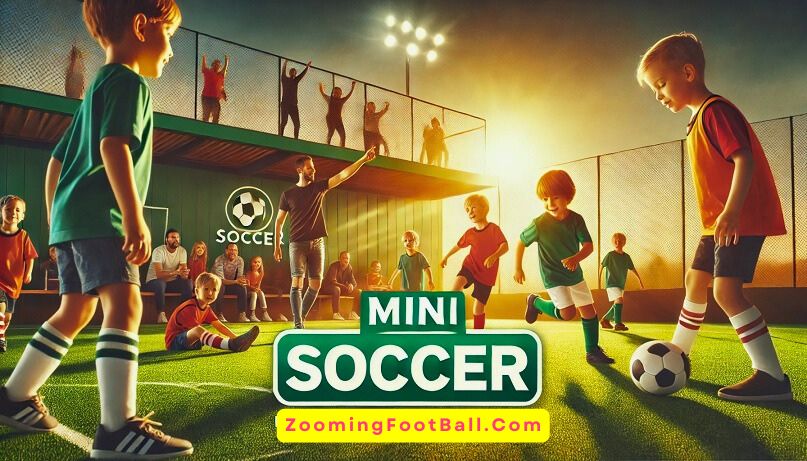Mini soccer is quickly becoming one of the most popular youth sports. It’s a fun, fast-paced version of soccer designed specifically for young players. Unlike traditional soccer, mini soccer uses smaller teams, smaller fields, and simpler rules.
This makes it perfect for kids who are just starting to learn the game. Whether you’re a player, coach, or parent, this guide will help you understand everything about mini soccer rules, gameplay, and why it’s such a great way for kids to develop skills and confidence.
In this article, we’ll cover the basics of mini soccer, including team sizes, field dimensions, and key rules. You’ll also learn about age-specific modifications, equipment requirements, and tips for coaching or supporting young players. By the end, you’ll have a clear understanding of how mini soccer works and why it’s becoming a favorite among youth leagues across the country.
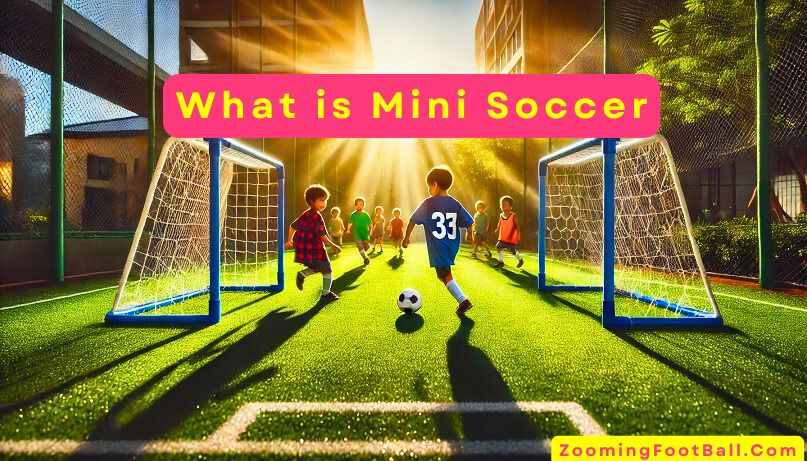
What is Mini Soccer?
Mini soccer is a simplified and scaled-down version of traditional soccer, specifically designed for young players. Unlike the standard 11v11 format, mini soccer typically features smaller teams, such as 4v4, 5v5, or 7v7.
The field is also significantly smaller, and the rules are streamlined to make the game more accessible and enjoyable for children. This format allows kids to touch the ball more frequently, stay actively involved, and develop their skills without the pressure of complex rules or large, intimidating fields.
The primary goal of mini soccer is to introduce young players to the sport in a fun and engaging way. It focuses on skill-building, teamwork, and confidence, making it an ideal starting point for kids aged 6 to 12. By reducing the number of players and simplifying the rules, mini soccer ensures that every child gets plenty of opportunities to participate and grow.
How Mini Soccer Differs from Traditional Soccer
Mini soccer differs from traditional 11v11 soccer in several key ways:
- Team Size: Instead of 11 players, mini soccer teams usually have 4 to 7 players. This smaller team size ensures that each child gets more playing time and a chance to be actively involved in the game.
- Field Dimensions: Mini soccer fields are much smaller than traditional fields. For example, a field for U6 players might be 20×30 yards, while a field for U12 players could be 40×60 yards. This smaller size keeps the game fast-paced and manageable for young players.
- Simplified Rules: Mini soccer often eliminates complex rules like the offside rule, making it easier for kids to understand and enjoy the game.
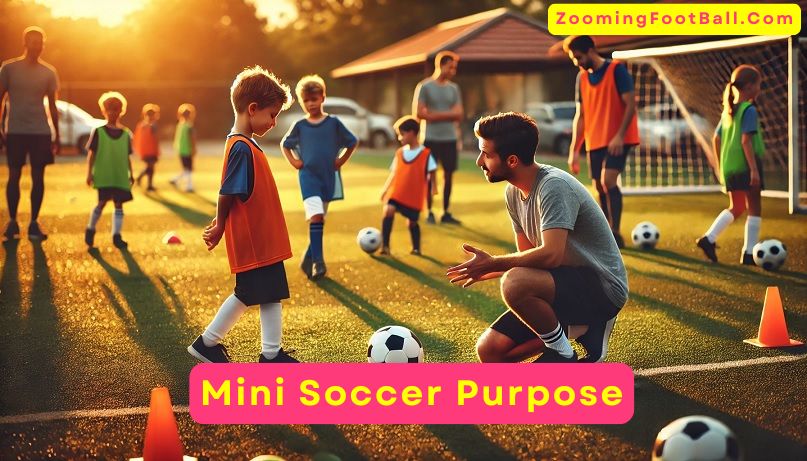
The Purpose of Mini Soccer
Mini soccer plays a crucial role in youth development. It’s not just about teaching kids how to play soccer; it’s about helping them grow as individuals. Here’s how mini soccer contributes to youth development:
Skill-Building: With more touches on the ball, kids improve their dribbling, passing, and shooting skills. The smaller field size also encourages quick decision-making and ball control.
Teamwork: Mini soccer teaches kids how to work together as a team. They learn to communicate, share the ball, and support their teammates.
Confidence: By participating in mini soccer, kids gain confidence in their abilities. They learn to take risks, make mistakes, and try again, which helps build resilience and self-esteem.

Popularity of Mini Soccer in the U.S.
Mini soccer has seen a significant rise in popularity across the United States. Many youth leagues and recreational programs have adopted mini soccer as the preferred format for introducing kids to the sport. According to the U.S. Youth Soccer Association, mini soccer is now a staple in youth soccer programs nationwide.
Here’s why mini soccer is so popular:
- Increased Participation: Smaller teams and shorter games ensure that every child gets a chance to play, keeping them engaged and motivated.
- Focus on Fun: Mini soccer prioritizes fun and skill development over competition, making it more appealing to young players and their parents.
- Accessibility: The simplified rules and smaller fields make mini soccer accessible to kids of all skill levels, even those who are just starting out.
Mini Soccer vs. Traditional Soccer: A Comparison
| Feature | Mini Soccer | Traditional Soccer |
| Team Size | 4-7 players | 11 players |
| Field Size | 20×30 to 40×60 yards | 100×50 to 130×100 yards |
| Game Duration | 10-15 minutes per half | 45 minutes per half |
| Offside Rule | Usually not used | Enforced |
| Focus | Skill-building and fun | Competition and strategy |
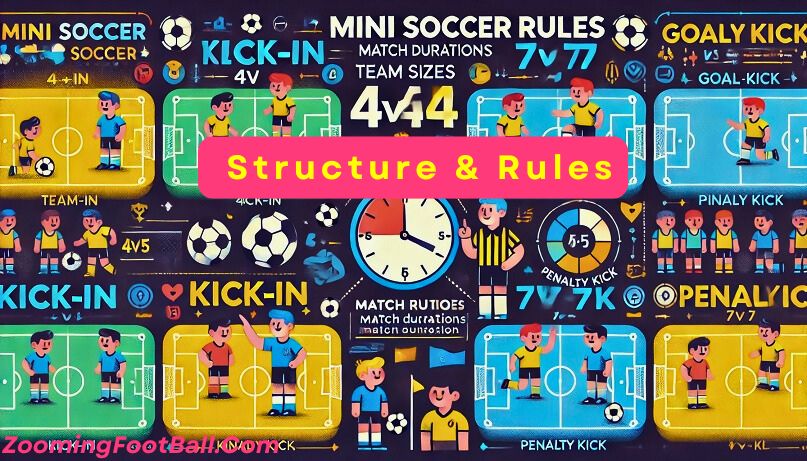
Key Mini Soccer Rules You Need to Know
Mini soccer is designed to be simple, fun, and accessible for young players. To achieve this, the rules are tailored to suit the needs of different age groups. Understanding these rules is essential for players, coaches, and parents to ensure a smooth and enjoyable experience. Below, we break down the key mini soccer rules, including team size, field dimensions, game duration, and more.
Team Size
One of the defining features of mini soccer is its smaller team size. Unlike traditional 11v11 soccer, mini soccer typically uses formats like 4v4, 5v5, or 7v7. These smaller teams ensure that every player gets plenty of touches on the ball and stays actively involved in the game.
4v4: This format is commonly used for the youngest players (U6-U8). With only four players on each team, kids have more opportunities to develop their skills and build confidence.
5v5: Slightly older players (U9-U10) often play 5v5. This format introduces a bit more structure while still keeping the game simple and fun.
7v7: For older kids (U11-U12), 7v7 is a popular format. It bridges the gap between mini soccer and traditional soccer, preparing players for larger teams and more complex rules.
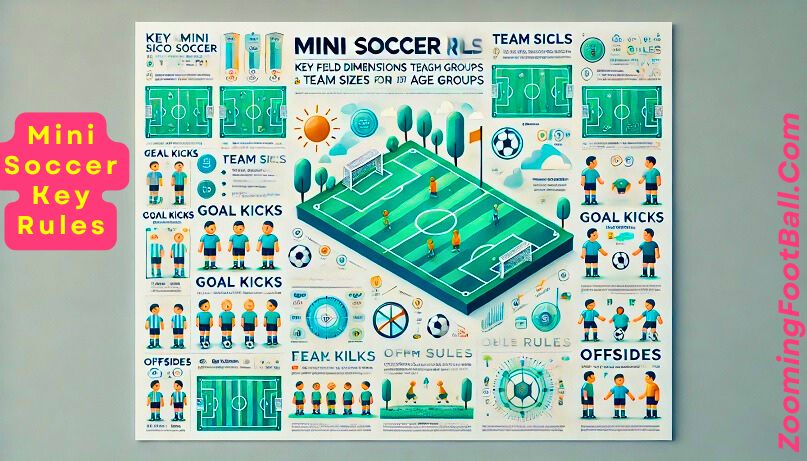
Field Dimensions
Mini soccer fields are much smaller than traditional soccer fields, making them more manageable for young players. The exact dimensions vary depending on the age group:
| Age Group | Field Size (Yards) | Goal Size (Feet) | Penalty Box Size (Yards) |
| U6-U8 | 20×30 | 4×6 | 10×12 |
| U9-U10 | 30×50 | 6×12 | 15×18 |
| U11-U12 | 40×60 | 6×18 | 20×24 |
These smaller fields keep the game fast-paced and ensure that players don’t get tired too quickly. The goals are also smaller, making it easier for young goalkeepers to defend.
Game Duration
Mini soccer games are shorter than traditional soccer matches to match the attention spans and energy levels of young players. Here’s a breakdown of typical game durations:
U6-U8: Matches are usually 10-12 minutes per half, with a 5-minute halftime break.
U9-U10: Games last 15 minutes per half, with a 5-10 minute halftime break.
U11-U12: Matches are 20-25 minutes per half, with a 10-minute halftime break.
Overtime rules are rarely used in mini soccer. If a game ends in a tie, it’s often left as a draw to emphasize fun and participation over competition.
No Offside Rule
One of the most significant differences between mini soccer and traditional soccer is the absence of the offside rule. In mini soccer, players are free to position themselves anywhere on the field without worrying about being offside.
This rule change simplifies the game for young players, allowing them to focus on developing their skills rather than understanding complex positioning rules. It also keeps the game flowing and encourages more scoring opportunities, which makes the experience more exciting for kids.
Substitutions
Mini soccer features flexible substitution rules to ensure that all players get a chance to participate. Substitutions can usually be made during stoppages in play, such as throw-ins, goal kicks, or halftime. Some leagues even allow unlimited substitutions, meaning coaches can rotate players in and out as often as they like.
This flexibility helps keep players engaged and prevents fatigue, especially during hot weather or long tournaments. It also gives coaches the opportunity to give every child equal playing time, which is a key focus in youth sports.
Ball Size
Using the right ball size is crucial for young players to develop proper technique and control. Mini soccer leagues typically use smaller balls to match the size and strength of the players:
Size 3 Ball: Used for the youngest players (U6-U8). This ball is lighter and easier to control, making it ideal for beginners.
Size 4 Ball: Used for older kids (U9-U12). This ball is slightly larger and heavier, preparing players for the transition to traditional soccer.
Mini Soccer Rules at a Glance
| Rule Category | Details |
| Team Size | 4v4 (U6-U8), 5v5 (U9-U10), 7v7 (U11-U12) |
| Field Dimensions | 20×30 yards (U6-U8), 30×50 yards (U9-U10), 40×60 yards (U11-U12) |
| Game Duration | 10-12 mins/half (U6-U8), 15 mins/half (U9-U10), 20-25 mins/half (U11-U12) |
| Offside Rule | Not used in most mini soccer leagues |
| Substitutions | Flexible, often unlimited |
| Ball Size | Size 3 (U6-U8), Size 4 (U9-U12) |
Understanding these key mini soccer rules will help players, coaches, and parents make the most of the experience. By focusing on simplicity, fun, and skill development, mini soccer provides a fantastic introduction to the world’s most popular sport.
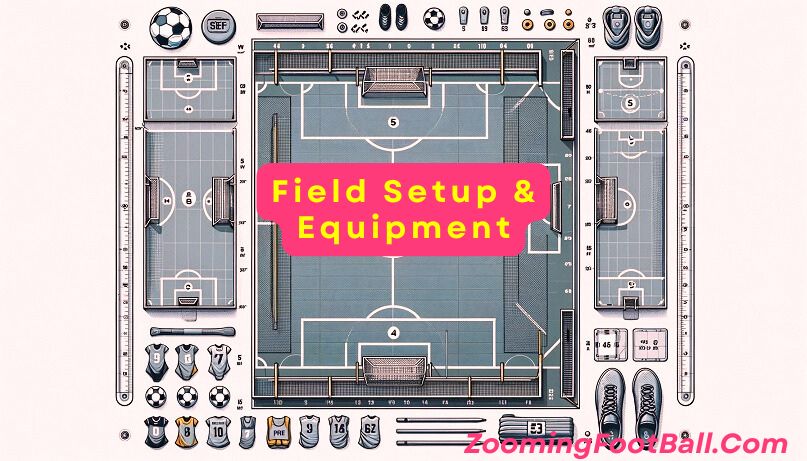
Equipment and Field Setup
Mini soccer is designed to be simple and accessible, but having the right equipment and a properly set up field is crucial for a smooth and enjoyable experience. Whether you’re a coach, parent, or player, understanding the equipment and field setup ensures that everyone is prepared and safe. Below, we’ll dive into the details of field layout, player gear, and referee equipment.
Field Layout
The field for mini soccer is much smaller than a traditional soccer field, making it easier for young players to navigate. The exact dimensions vary depending on the age group, but here’s a general guide:
| Age Group | Field Size (Yards) | Goal Size (Feet) | Penalty Box Size (Yards) | Center Circle (Yards) |
| U6-U8 | 20×30 | 4×6 | 10×12 | 5 |
| U9-U10 | 30×50 | 6×12 | 15×18 | 8 |
| U11-U12 | 40×60 | 6×18 | 20×24 | 10 |
The field should be clearly marked with boundary lines, a center circle, and penalty areas. Cones or small flags can be used to mark the corners, and the goals should be securely anchored to the ground.
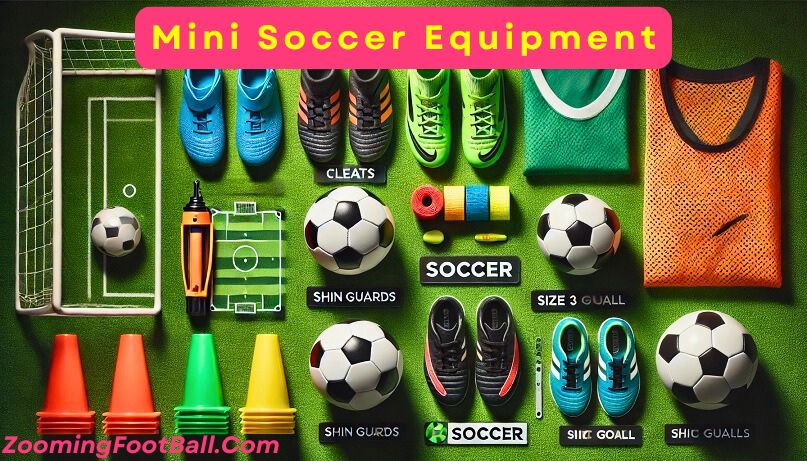
Player Gear
Mini soccer requires basic equipment to ensure player safety and comfort. Here’s a list of required and optional gear:
Required Equipment
- Shin Guards: These protect players’ legs from injuries during tackles or collisions.
- Cleats: Soccer cleats provide traction on grass or turf, helping players run and turn safely.
- Uniforms: Teams typically wear matching jerseys, shorts, and socks. Goalkeepers wear a different-colored jersey to distinguish themselves.
Optional Equipment
- Soccer Ball: While most leagues provide game balls, having a personal ball for practice is helpful.
- Water Bottle: Staying hydrated is essential, especially during long practices or games.
- Goalkeeper Gloves: These provide better grip and protection for goalkeepers.
Referee Equipment
Referees play a vital role in ensuring fair play and safety during mini soccer games. Here’s a list of essential referee equipment:
1-Whistle: Used to signal the start and stop of play, as well as fouls or other infractions.
2-Stopwatch: Helps the referee keep track of game time and halftime breaks.
3-Flags: Used by assistant referees to signal offsides, throw-ins, or corner kicks.
4-Yellow and Red Cards: These are used to discipline players for serious fouls or unsportsmanlike behavior.
Equipment Checklist
Category | Items |
| Player Gear | Shin guards, cleats, uniforms, water bottle |
| Referee Gear | Whistle, stopwatch, flags, cards |
| Field Setup | Goals, cones, boundary markers |
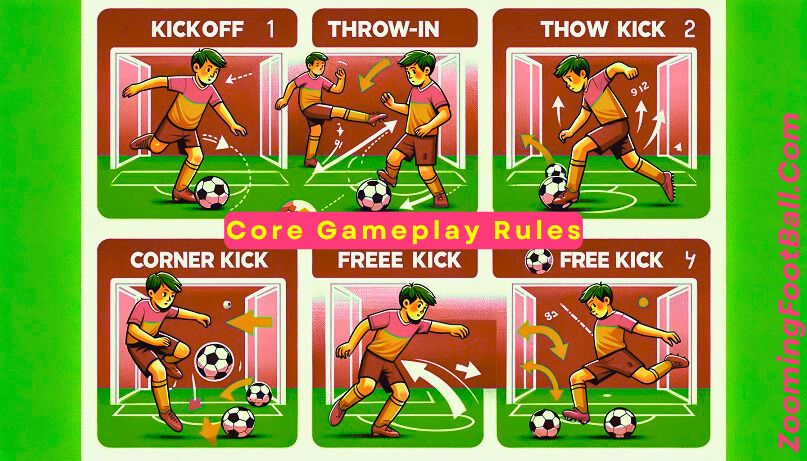
Core Gameplay Rules
Mini soccer is all about keeping the game simple, fun, and engaging for young players. Understanding the core gameplay rules is essential for players, coaches, and parents to ensure a smooth and enjoyable experience. Below, we’ll break down the key rules, including kickoffs, scoring, fouls, and set pieces like free kicks and penalty kicks.
Kickoff and Restarts
The game begins with a kickoff, where one team starts play from the center of the field. Here’s how it works:
- Kickoff: The ball is placed at the center spot, and one player passes it to a teammate. The opposing team must stay outside the center circle until the ball is in play.
- Throw-ins: When the ball goes out of bounds along the sidelines, the opposing team restarts play with a throw-in. The player must use both hands and keep both feet on the ground.
- Goal Kicks: If the attacking team kicks the ball out of bounds behind the goal line, the defending team restarts play with a goal kick. The ball is placed inside the penalty area and kicked back into play.
- Corner Kicks: If the defending team kicks the ball out of bounds behind their own goal line, the attacking team gets a corner kick. The ball is placed in the corner arc and kicked into play.
These restarts keep the game flowing and give players plenty of opportunities to practice different skills.
Scoring Rules
Scoring in mini soccer is straightforward: a goal is scored when the entire ball crosses the goal line between the goalposts and under the crossbar. Here are some key points to remember:
- No Tiebreakers: In most mini soccer leagues, games that end in a tie are left as draws. The focus is on participation and fun rather than competition.
- Goalkeeper Rules: The goalkeeper can use their hands inside the penalty area but must release the ball within 6 seconds.
Scoring goals is one of the most exciting parts of mini soccer, and the simplified rules make it easier for young players to experience this thrill.
Fouls and Penalties
Mini soccer emphasizes fair play, but fouls can still occur. Here’s a breakdown of common fouls and how they’re handled:
- Common Fouls: These include tripping, pushing, handballs, and dangerous play. When a foul occurs, the opposing team is awarded a free kick.
- Yellow Cards: Referees may issue a yellow card for serious fouls or unsportsmanlike behavior. This serves as a warning to the player.
- Red Cards: A red card is given for violent conduct or repeated offenses. The player must leave the field, and their team plays with one fewer player.
Mini soccer leagues often place a strong emphasis on teaching kids about fair play and respect for opponents, teammates, and referees.
Free Kicks and Penalty Kicks
Free kicks and penalty kicks are important parts of mini soccer. Here’s how they work:
- Free Kicks: When a foul occurs, the opposing team gets a free kick. The ball is placed at the spot of the foul, and the opposing team must stay at least 5 yards away until the ball is in play.
- Penalty Kicks: If a foul occurs inside the penalty area, the attacking team is awarded a penalty kick. The ball is placed on the penalty spot, and only the goalkeeper can defend the goal.
These set pieces add excitement to the game and give players a chance to practice their shooting skills.
Core Gameplay Rules at a Glance
| Rule Category | Details |
| Kickoff | Starts at the center spot; opposing team stays outside the center circle |
| Throw-ins | Use both hands; keep both feet on the ground |
| Goal Kicks | Taken from inside the penalty area |
| Corner Kicks | Taken from the corner arc |
| Scoring | Goal counts when the ball fully crosses the goal line |
| Fouls | Tripping, pushing, handballs, dangerous play |
| Yellow/Red Cards | Warnings and ejections for serious offenses |
| Free Kicks | Awarded for fouls; opponents must stay 5 yards away |
| Penalty Kicks | Awarded for fouls inside the penalty area |
Understanding these core gameplay rules ensures that mini soccer is fun, fair, and engaging for everyone involved. By focusing on simplicity and skill development, mini soccer provides a fantastic introduction to the world’s most popular sport.
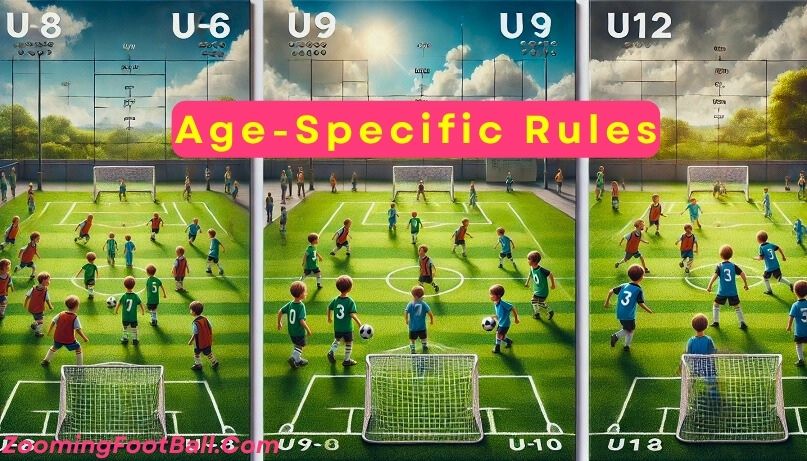
Age-Specific Mini Soccer Rules
Mini soccer is designed to grow with young players, adapting to their physical and cognitive development as they age. The rules are tailored to each age group, ensuring that the game remains fun, safe, and challenging. Below, we’ll explore the age-specific mini soccer rules for U6-U8, U9-U10, and U11-U12 players, highlighting the key modifications and transitions.
U6-U8 Rules
For the youngest players (ages 6-8), mini soccer focuses on fun, participation, and basic skill development. The rules are simplified to keep the game engaging and stress-free.
- Team Size: Teams typically play 4v4, ensuring that every child gets plenty of touches on the ball.
- Field Dimensions: The field is small, usually 20×30 yards, making it easy for kids to navigate.
- Game Duration: Matches are short, with 10-12 minute halves and a 5-minute halftime break.
- No Heading: To protect young players, heading the ball is not allowed.
- No Goalkeepers: In some leagues, goalkeepers are not used to encourage all players to participate actively.
- No Offside Rule: The offside rule is omitted to keep the game simple and flowing.
The focus at this age is on fun, basic skills, and teamwork. Coaches and parents are encouraged to create a positive and supportive environment.
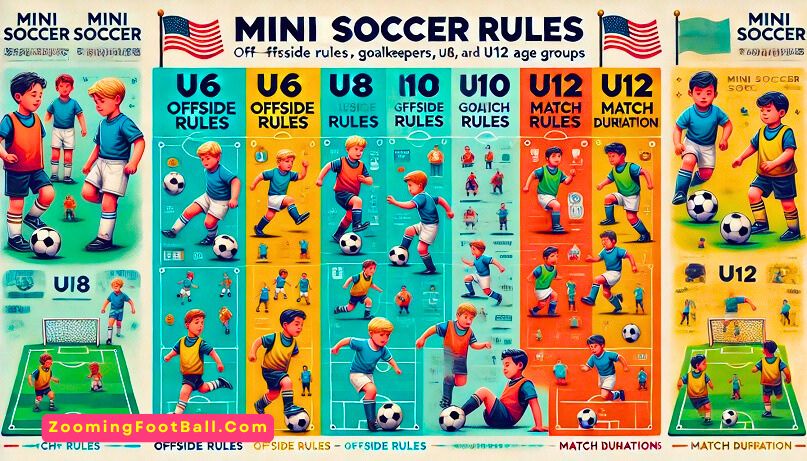
U9-U10 Rules
As players grow older (ages 9-10), mini soccer introduces slightly more structure while still prioritizing fun and skill development.
- Team Size: Teams usually play 5v5 or 7v7, depending on the league.
- Field Dimensions: The field is larger, typically 30×50 yards, to accommodate the players’ growing abilities.
- Game Duration: Matches last 15 minutes per half, with a 5-10 minute halftime break.
- Goalkeepers: Goalkeepers are introduced at this stage, and they can use their hands within the penalty area.
- No Heading: Heading is still prohibited to ensure player safety.
- Basic Tactics: Coaches may start introducing simple tactics, such as positioning and passing patterns.
This age group serves as a transition phase, preparing players for more structured gameplay in the future.
U11-U12 Rules
For older players (ages 11-12), mini soccer begins to align more closely with traditional soccer rules, while still maintaining a focus on development and enjoyment.
- Team Size: Teams typically play 7v7, bridging the gap between mini soccer and full-sized soccer.
- Field Dimensions: The field is larger, usually 40×60 yards, with goal sizes increasing to 6×18 feet.
- Game Duration: Matches last 20-25 minutes per half, with a 10-minute halftime break.
- Heading: Some leagues allow heading at this age, but with restrictions to ensure safety.
- Offside Rule: The offside rule may be introduced to prepare players for traditional soccer.
- Tactical Play: Coaches can focus on more advanced tactics, such as formations and set pieces.
At this stage, players are encouraged to develop their technical skills, game awareness, and team dynamics.
Age-Specific Rules Comparison
| Age Group | Team Size | Field Size (Yards) | Game Duration (Per Half) | Key Modifications |
| U6-U8 | 4v4 | 20×30 | 10-12 minutes | No heading, no goalkeepers, no offside |
| U9-U10 | 5v5/7v7 | 30×50 | 15 minutes | Goalkeepers introduced, no heading |
| U11-U12 | 7v7 | 40×60 | 20-25 minutes | Offside rule introduced, heading allowed (with restrictions) |
Understanding these age-specific mini soccer rules ensures that players, coaches, and parents can create a positive and developmentally appropriate experience. By tailoring the game to each age group, mini soccer helps young athletes grow their skills, confidence, and love for the sport.

Benefits of Mini Soccer for Kids
Mini soccer is more than just a fun activity—it’s a powerful tool for youth development. Designed specifically for young players, mini soccer offers a range of benefits that go beyond the field.
From improving physical skills to building confidence and teamwork, this scaled-down version of soccer provides a foundation for both athletic and personal growth. Below, we’ll explore the key benefits of mini soccer for kids, including skill development, increased participation, and the fostering of social skills and self-esteem.
Skill Development
Mini soccer is an excellent way for kids to develop essential soccer skills in a fun and supportive environment. The smaller teams and simplified rules allow players to focus on the basics, such as dribbling, passing, and shooting.
- Dribbling: With fewer players on the field, kids have more opportunities to practice controlling the ball and navigating through opponents.
- Passing: Mini soccer encourages quick, short passes, helping players develop accuracy and teamwork.
- Shooting: The smaller field size means more scoring opportunities, allowing kids to practice their shooting skills and build confidence in front of the goal.
These skills form the foundation of soccer and are crucial for players as they progress to more advanced levels.

Increased Participation
One of the standout features of mini soccer is its ability to keep kids engaged and actively involved. Traditional 11v11 soccer can sometimes leave younger players feeling lost or disconnected, but mini soccer solves this problem with its smaller teams and shorter games.
- Smaller Teams: With formats like 4v4 or 5v5, every player gets plenty of touches on the ball and stays involved in the action.
- Shorter Games: Mini soccer matches are typically 10-25 minutes per half, which matches the attention spans and energy levels of young players.
- Equal Playing Time: Many mini soccer leagues emphasize equal playing time for all participants, ensuring that every child feels valued and included.
This increased participation helps kids stay motivated and develop a lifelong love for the sport.
Confidence and Teamwork : Mini Soccer Rules
Mini soccer isn’t just about physical skills—it’s also a fantastic way for kids to build confidence and learn the value of teamwork.
- Confidence: By participating in mini soccer, kids gain a sense of accomplishment and self-esteem. Scoring a goal, making a great pass, or simply improving their skills can boost their confidence both on and off the field.
- Teamwork: Mini soccer teaches kids how to work together as a team. They learn to communicate, share the ball, and support their teammates, which are valuable life skills.
- Social Skills: Playing mini soccer helps kids make new friends and develop social skills. They learn to respect their opponents, listen to their coaches, and celebrate their teammates’ successes.
These benefits extend beyond the soccer field, helping kids grow into well-rounded individuals.
Benefits of Mini Soccer at a Glance
| Benefit Category | Key Points |
| Skill Development | Improves dribbling, passing, and shooting skills |
| Increased Participation | Smaller teams and shorter games keep kids engaged and involved |
| Confidence | Builds self-esteem through accomplishments and skill improvement |
| Teamwork | Teaches communication, cooperation, and respect for others |
Mini soccer offers a unique combination of physical, social, and emotional benefits for young players. By focusing on skill development, participation, and teamwork, mini soccer helps kids build a strong foundation for both soccer and life. Whether they’re dribbling past an opponent, celebrating a goal, or cheering on a teammate, kids who play mini soccer gain valuable experiences that will stay with them for years to come.

Mini Soccer Rules: Tips for Coaches and Parents
Mini soccer is a fantastic way for kids to learn and enjoy the game, but the experience is greatly influenced by the support they receive from coaches and parents. Whether you’re guiding a team from the sidelines or cheering from the stands, your role is crucial in creating a positive and rewarding environment.
Below, we’ll explore tips for coaches and parents, including practice drills, game-day strategies, gear recommendations, and the importance of sportsmanship.
For Coaches
Coaches play a vital role in shaping young players’ experiences in mini soccer. Here are some practical tips to help you create a fun and productive environment:
Practice Drills
Dribbling Drills: Set up cones in a straight line or zigzag pattern and have players practice dribbling through them. This improves ball control and agility.
Passing Drills: Use small-sided games like 2v2 or 3v3 to encourage quick, accurate passing.
Shooting Drills: Create a mini goal and have players take shots from different angles to improve their accuracy and confidence.
Game-Day Strategies
Rotate Positions: Give players the chance to try different positions, such as forward, midfielder, and defender. This helps them develop a well-rounded understanding of the game.
Keep It Simple: Focus on one or two key objectives for each game, such as passing to a teammate or staying in position.
Encourage Fair Play: Emphasize the importance of playing by the rules and respecting opponents, referees, and teammates.
Building Team Spirit
Celebrate Effort: Praise players for their effort and improvement, not just their goals or wins.
Team Huddles: Use pre-game and post-game huddles to build camaraderie and discuss what went well and what can be improved.
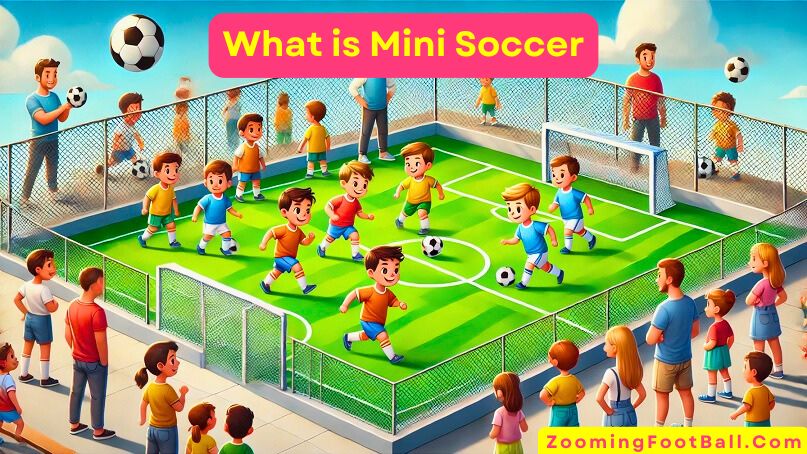
For Parents
Parents are the backbone of support for young players. Here’s how you can help your child get the most out of their mini soccer experience:
Gear Recommendations
- Shin Guards: Ensure your child wears shin guards to protect their legs during play.
- Cleats: Invest in a good pair of soccer cleats for better traction on grass or turf.
- Water Bottle: Keep your child hydrated with a reusable water bottle.
Fostering a Positive Attitude
- Encourage, Don’t Pressure: Focus on effort and enjoyment rather than winning or scoring goals.
- Be a Role Model: Demonstrate good sportsmanship by respecting coaches, referees, and other parents.
- Celebrate Small Wins: Acknowledge your child’s progress, whether it’s mastering a new skill or simply having fun.
Supporting Your Child
- Attend Games: Show your support by attending games and cheering for the team.
- Practice at Home: Spend time practicing basic skills like dribbling and passing in the backyard or at a local park.
- Stay Positive: Encourage your child to keep trying, even if they make mistakes or lose a game.
Sportsmanship
Sportsmanship is a cornerstone of mini soccer. Teaching kids to respect referees, opponents, and teammates is essential for creating a positive and enjoyable experience for everyone involved.
- Respect for Referees: Teach players to accept the referee’s decisions, even if they disagree. Referees are there to ensure fair play and safety.
- Respect for Opponents: Encourage players to shake hands with their opponents before and after the game. This fosters a sense of camaraderie and mutual respect.
- Teamwork and Fair Play: Emphasize the importance of playing as a team and following the rules. Winning is less important than playing with integrity and respect.
Tips for Coaches and Parents at a Glance
| Role | Key Tips |
| Coaches | Use fun drills, rotate positions, encourage fair play, celebrate effort |
| Parents | Provide proper gear, foster positivity, attend games, practice at home |
| Sportsmanship | Respect referees, opponents, and teammates; emphasize fair play |
By following these tips, coaches and parents can create a supportive and enjoyable environment for young players. Mini soccer is about more than just learning the game—it’s about building confidence, teamwork, and a lifelong love for soccer. Together, we can help kids grow both on and off the field!
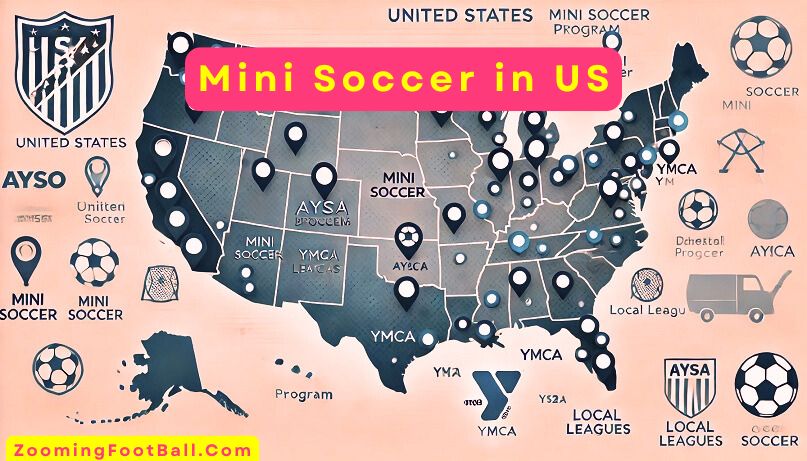
Finding Mini Soccer Programs in the U.S.
Mini soccer is a fantastic way for kids to get involved in sports, but finding the right program can sometimes feel overwhelming. Fortunately, there are plenty of resources available to help you locate mini soccer programs near you. Whether you’re looking for local leagues, community centers, or online resources, this guide will point you in the right direction.
Local Leagues
Local soccer leagues are one of the best places to find mini soccer programs for kids. These leagues are often organized by age group and skill level, making it easy to find a program that’s a good fit for your child.
- U.S. Youth Soccer Association: The U.S. Youth Soccer Association is a great starting point. They have a league finder tool that allows you to search for programs by state and region.
- AYSO (American Youth Soccer Organization): AYSO is another excellent resource. They offer mini soccer programs for kids as young as 4 years old. Visit their website at www.ayso.org to find a local chapter.
- Recreational Leagues: Many towns and cities have recreational leagues that offer mini soccer. Check with your local parks and recreation department for more information.
These leagues often provide a fun, low-pressure environment where kids can learn the basics of soccer and make new friends.
Community Centers: Mini Soccer Rules
Community centers and schools are another great option for finding mini soccer programs. These programs are often more affordable and accessible than larger leagues, making them a popular choice for families.
- Local Schools: Many elementary and middle schools offer after-school soccer programs or partner with local leagues to provide mini soccer opportunities.
- YMCA: The YMCA is known for its youth sports programs, including mini soccer.
- Boys & Girls Clubs: These clubs often offer sports programs, including mini soccer, as part of their activities.
Community centers and schools are a great way to get involved in mini soccer without the commitment of a larger league.
Online Resources
The internet is a treasure trove of information when it comes to finding mini soccer programs. Here are some reputable online resources to explore:
- SoccerWire: SoccerWire is a comprehensive resource for all things soccer. They have a directory of youth soccer programs that includes mini soccer.
- Positive Coaching Alliance: This organization focuses on creating a positive sports experience for kids. Visit www.positivecoach.org for tips on finding the right program.
- Social Media: Many local leagues and community centers advertise their programs on social media platforms like Facebook and Instagram. A quick search can often lead you to nearby opportunities.
These online resources make it easy to research programs, read reviews, and connect with coaches and organizers.
Finding Mini Soccer Programs at a Glance
| Resource Type | Examples |
| Local Leagues | U.S. Youth Soccer, AYSO, recreational leagues |
| Community Centers | Schools, YMCA, Boys & Girls Clubs |
| Online Resources | SoccerWire, Positive Coaching Alliance, social media |
Finding the right mini soccer program for your child doesn’t have to be difficult. With these resources, you can easily locate a program that fits your family’s needs and helps your child develop a love for the game. So, what are you waiting for? Start exploring today and get your child involved in the exciting world of mini soccer! You may also like: Rules Of Soccer
FAQs About Mini Soccer Rules
Here are some of the most commonly asked questions about mini soccer, along with clear and concise answers to help you understand the game better.
What is mini soccer?
Mini soccer is a simplified version of traditional soccer designed for young players. It features smaller teams (like 4v4 or 7v7), smaller fields, and easier rules to help kids learn the game while having fun.
What age is mini soccer for?
Mini soccer is typically for kids aged 6 to 12. The rules and field sizes vary by age group, making it suitable for different skill levels.
What are the benefits of mini soccer for kids?
Mini soccer helps kids develop soccer skills like dribbling, passing, and shooting. It also promotes teamwork, confidence, and physical fitness in a fun and engaging way.
How long is a mini soccer game?
Game lengths depend on the age group. For U6-U8, games are 10-12 minutes per half. For U9-U10, they’re 15 minutes per half, and for U11-U12, they’re 20-25 minutes per half.
What equipment is needed for mini soccer?
Players need shin guards, cleats, and a uniform. Goalkeepers also need gloves. Most leagues provide the ball, but having a personal one for practice is helpful.
Are there goalkeepers in mini soccer?
For younger age groups (U6-U8), goalkeepers are often not used. For older kids (U9-U12), goalkeepers are introduced to teach basic defensive skills.
Is there an offside rule in mini soccer?
Most mini soccer leagues do not use the offside rule, especially for younger players. This keeps the game simple and fast-paced.
More FAQs About Mini Soccer Rules
What’s the difference between mini soccer and regular soccer?
Mini soccer uses smaller teams, smaller fields, and simpler rules compared to regular 11v11 soccer. It’s designed to be more accessible and fun for young players.
How can I help my child succeed in mini soccer?
Encourage them to practice basic skills like dribbling and passing. Attend their games, cheer them on, and focus on effort and enjoyment rather than winning.
What are the rules for substitutions in mini soccer?
Substitutions are usually unlimited and can be made during stoppages in play. This ensures all players get equal playing time.
Can girls play mini soccer?
Absolutely! Mini soccer is co-ed in most leagues, and girls are encouraged to participate and enjoy the game just as much as boys.
What’s the best way to teach sportsmanship in mini soccer?
Teach kids to respect referees, opponents, and teammates. Emphasize fair play and celebrate effort, not just goals or wins.

Conclusion About Mini Soccer Rules
Mini soccer is more than just a game—it’s a gateway to a lifetime of soccer enjoyment. With simplified rules, smaller teams, and a focus on fun, it’s the perfect way for kids to learn the sport and develop essential skills. Whether you’re a player, coach, or parent, we hope this guide has given you a clear understanding of mini soccer rules and how to get started.
Ready to join the mini soccer movement? Share your experiences or questions in the comments below, and let’s keep the conversation going!

Oliver Brown, a seasoned football blogger with a knack for insightful commentary, brings decades of passion and expertise to Zooming Football. Known for his sharp analysis and engaging storytelling, Oliver delves deep into the game’s nuances, offering readers a unique perspective on football’s most captivating stories and strategies.

